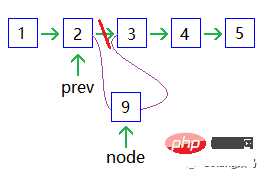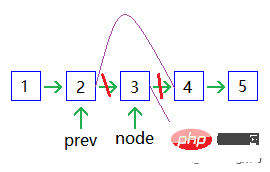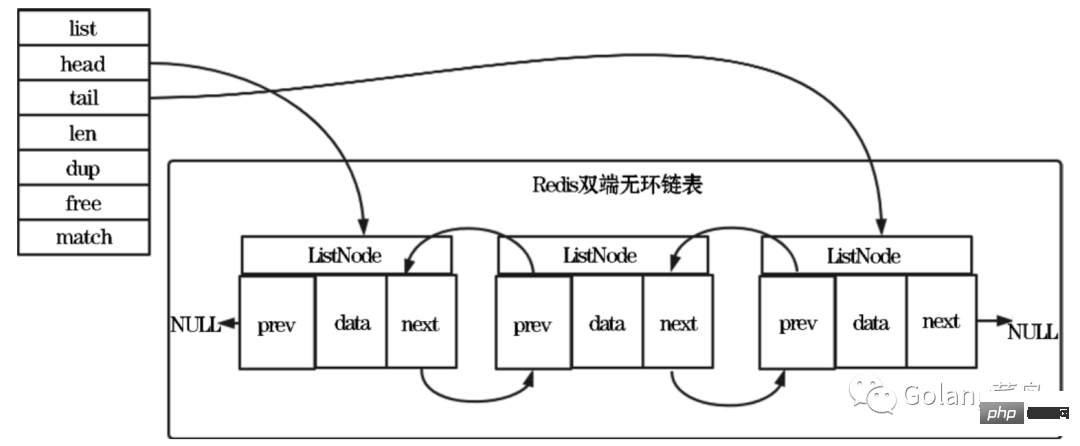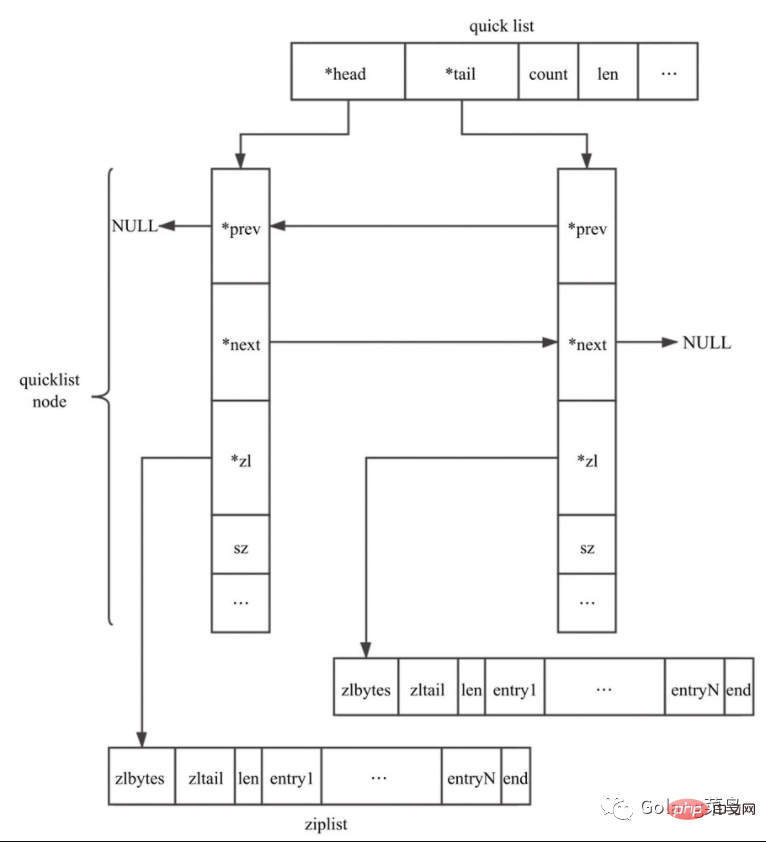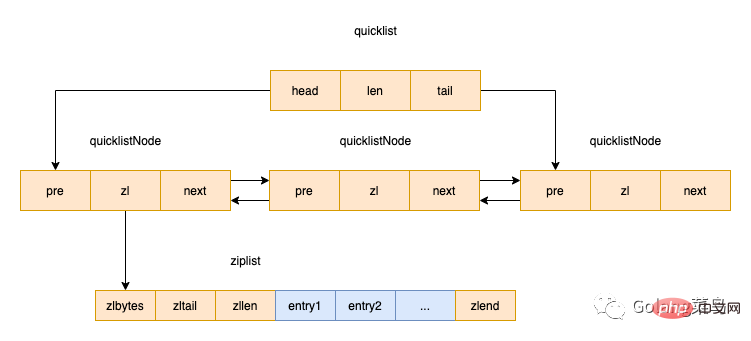redis study notes-list principle
list Basic functions
| ##Commands | Description |
|---|---|
| #BLPOP key1,key2,... timeout | Remove and get the first element of the list, if the list has no elements it will block The list waits until it times out or the element is popped. |
| ##Move out and Get the | last element of the list. If there is no element in the list, the list will be blocked until the wait times out or a pop-up element is found. |
| BRPOPLPUSH source destination timeout | pop from list A value that inserts the popped element into another list and returns it; if the list has no elements, the list will be blocked until the wait times out or a popupable element is found. |
| LIndex key index | 通过索引获取列表中的元素 |
| Linsert key before/after pivot value | 在列表的元素前或者后插入元素 |
| LLEN key | 获取列表长度 |
| LPOP key | 移出并获取列表的第一个元素 |
| ##LPUSH key value1,value2,… | will One or more values are inserted into the head of the list |
| LPUSHX key value | Insert a value into the head of an existing list |
| ##LRANGE key srart stop | Get the elements within the specified range of the list |
| Remove list element | |
| Set the value of a list element by index | |
| Pruning a list means that only the elements within the specified range are retained in the list, and the elements that are not within the specified range are deleted. The index starts from 0, and the range is inclusive. | |
| RPOP key | remove listThe last element, the return value is the removed element |
| RPOPPUSH source destination | Remove the last element of the list and replace The element is added to another list and returns |
| RPUSH key value1 value2 …… | Add one or more values to the end of the list |
| ##RPUSHX key value | Add a value to an already existing list |
| ##Value | ##Meaning |
|---|---|
| ##Special value means no compression | ##1 |
| ##There is 1 on each end of the quicklist The nodes are not compressed, the middle nodes are compressed | 2 |
| There are 2 nodes at both ends of the quicklist that are not compressed, and the nodes in the middle are compressed | n | There are n nodes at both ends of the quicklist that are not compressed, and the nodes in the middle are compressed |
There is also a fill field, which means the maximum capacity of each quicknode node , different values have different meanings, the default is -2, of course it can also be configured to other values;
##list-max-ziplist-size -2- When the value is a positive number, it indicates the length of the ziplist on the quicklistNode node. For example, when this value is 5, the ziplist of each quicklistNode node contains at most 5 data items
- When the value is a negative number, Indicates that the length of the ziplist on the quicklistNode node is limited according to the number of bytes. The optional values are -1 to -5.
| Value | Meaning |
|---|---|
| -1 | ziplist node maximum The maximum number of ziplist nodes is 4kb |
| ##-2 | 8kb |
| -3 | ziplist node maximum is 16kb |
| ##-4 | ##ziplist node maximum is 32kb|
| -5 | ##The maximum ziplist node size is 64kb |
Why is there configuration provided?
#The shorter the ziplist, the more memory fragments will occur, affecting storage efficiency. When a ziplist only stores one element, the quicklist degenerates into a doubly linked list.
The longer the ziplist, the more difficult it is to allocate a large continuous memory space for the ziplist. The larger the value, the more small blocks of memory space will be wasted. When the quicklist has only one node and all elements are stored in a ziplist, the quicklist degenerates into a ziplist.
Conclusion
Although we do not fully understand its source code, we can also familiarize ourselves with a design idea of redis through this article. And know how it is optimized step by step. Let's get a general idea of performance.
The above is the detailed content of redis study notes-list principle. For more information, please follow other related articles on the PHP Chinese website!

Hot AI Tools

Undresser.AI Undress
AI-powered app for creating realistic nude photos

AI Clothes Remover
Online AI tool for removing clothes from photos.

Undress AI Tool
Undress images for free

Clothoff.io
AI clothes remover

Video Face Swap
Swap faces in any video effortlessly with our completely free AI face swap tool!

Hot Article

Hot Tools

Notepad++7.3.1
Easy-to-use and free code editor

SublimeText3 Chinese version
Chinese version, very easy to use

Zend Studio 13.0.1
Powerful PHP integrated development environment

Dreamweaver CS6
Visual web development tools

SublimeText3 Mac version
God-level code editing software (SublimeText3)

Hot Topics
 1657
1657
 14
14
 1415
1415
 52
52
 1309
1309
 25
25
 1257
1257
 29
29
 1229
1229
 24
24
 How to build the redis cluster mode
Apr 10, 2025 pm 10:15 PM
How to build the redis cluster mode
Apr 10, 2025 pm 10:15 PM
Redis cluster mode deploys Redis instances to multiple servers through sharding, improving scalability and availability. The construction steps are as follows: Create odd Redis instances with different ports; Create 3 sentinel instances, monitor Redis instances and failover; configure sentinel configuration files, add monitoring Redis instance information and failover settings; configure Redis instance configuration files, enable cluster mode and specify the cluster information file path; create nodes.conf file, containing information of each Redis instance; start the cluster, execute the create command to create a cluster and specify the number of replicas; log in to the cluster to execute the CLUSTER INFO command to verify the cluster status; make
 How to clear redis data
Apr 10, 2025 pm 10:06 PM
How to clear redis data
Apr 10, 2025 pm 10:06 PM
How to clear Redis data: Use the FLUSHALL command to clear all key values. Use the FLUSHDB command to clear the key value of the currently selected database. Use SELECT to switch databases, and then use FLUSHDB to clear multiple databases. Use the DEL command to delete a specific key. Use the redis-cli tool to clear the data.
 How to read redis queue
Apr 10, 2025 pm 10:12 PM
How to read redis queue
Apr 10, 2025 pm 10:12 PM
To read a queue from Redis, you need to get the queue name, read the elements using the LPOP command, and process the empty queue. The specific steps are as follows: Get the queue name: name it with the prefix of "queue:" such as "queue:my-queue". Use the LPOP command: Eject the element from the head of the queue and return its value, such as LPOP queue:my-queue. Processing empty queues: If the queue is empty, LPOP returns nil, and you can check whether the queue exists before reading the element.
 How to configure Lua script execution time in centos redis
Apr 14, 2025 pm 02:12 PM
How to configure Lua script execution time in centos redis
Apr 14, 2025 pm 02:12 PM
On CentOS systems, you can limit the execution time of Lua scripts by modifying Redis configuration files or using Redis commands to prevent malicious scripts from consuming too much resources. Method 1: Modify the Redis configuration file and locate the Redis configuration file: The Redis configuration file is usually located in /etc/redis/redis.conf. Edit configuration file: Open the configuration file using a text editor (such as vi or nano): sudovi/etc/redis/redis.conf Set the Lua script execution time limit: Add or modify the following lines in the configuration file to set the maximum execution time of the Lua script (unit: milliseconds)
 How to use the redis command line
Apr 10, 2025 pm 10:18 PM
How to use the redis command line
Apr 10, 2025 pm 10:18 PM
Use the Redis command line tool (redis-cli) to manage and operate Redis through the following steps: Connect to the server, specify the address and port. Send commands to the server using the command name and parameters. Use the HELP command to view help information for a specific command. Use the QUIT command to exit the command line tool.
 How to set the redis expiration policy
Apr 10, 2025 pm 10:03 PM
How to set the redis expiration policy
Apr 10, 2025 pm 10:03 PM
There are two types of Redis data expiration strategies: periodic deletion: periodic scan to delete the expired key, which can be set through expired-time-cap-remove-count and expired-time-cap-remove-delay parameters. Lazy Deletion: Check for deletion expired keys only when keys are read or written. They can be set through lazyfree-lazy-eviction, lazyfree-lazy-expire, lazyfree-lazy-user-del parameters.
 How to implement redis counter
Apr 10, 2025 pm 10:21 PM
How to implement redis counter
Apr 10, 2025 pm 10:21 PM
Redis counter is a mechanism that uses Redis key-value pair storage to implement counting operations, including the following steps: creating counter keys, increasing counts, decreasing counts, resetting counts, and obtaining counts. The advantages of Redis counters include fast speed, high concurrency, durability and simplicity and ease of use. It can be used in scenarios such as user access counting, real-time metric tracking, game scores and rankings, and order processing counting.
 How to optimize the performance of debian readdir
Apr 13, 2025 am 08:48 AM
How to optimize the performance of debian readdir
Apr 13, 2025 am 08:48 AM
In Debian systems, readdir system calls are used to read directory contents. If its performance is not good, try the following optimization strategy: Simplify the number of directory files: Split large directories into multiple small directories as much as possible, reducing the number of items processed per readdir call. Enable directory content caching: build a cache mechanism, update the cache regularly or when directory content changes, and reduce frequent calls to readdir. Memory caches (such as Memcached or Redis) or local caches (such as files or databases) can be considered. Adopt efficient data structure: If you implement directory traversal by yourself, select more efficient data structures (such as hash tables instead of linear search) to store and access directory information





